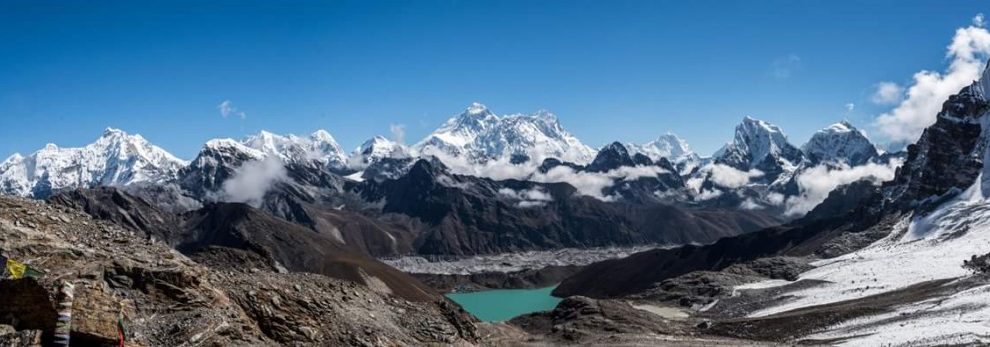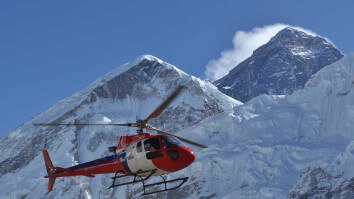The Gokyo Valley Trek in 2025/2026 is a perfect alternative to the Everest Base Camp trek, offering trekkers breathtaking views of the Himalayas, serene turquoise lakes, and a less crowded route. Located in the Khumbu region of Nepal, the trek centers around the Gokyo Lakes, a chain of beautiful glacial lakes considered sacred by both Hindus and Buddhists.
The journey typically begins with a flight to Lukla from Kathmandu or Ramechap, followed by a gradual ascent through traditional Sherpa villages, rhododendron forests, and alpine landscapes.
A highlight of the trek is the ascent of Gokyo Ri (5,357m), which provides panoramic views of Mount Everest, Lhotse, Makalu, and Cho Oyu—four of the world’s highest peaks. The trek also provides you the chance to witness the Ngozumpa Glacier, the longest glacier in Nepal. Ideal for adventurous hikers looking for fewer people and spectacular Himalayan scenery, the Gokyo Valley Trek usually takes 14 days to complete. It is a moderately challenging adventure.
Indulge in the joy of peaceful surroundings with Gokyo Valley Trek in the Everest region. The alternative trekking route to the Everest Base Camp, it offers exciting trekking and cultural experience. Unlike, other popular trekking trails like Everest Base Camp Trek, the Gokyo Valley Trek trail is a less explored route.
Not everyone has the desire to follow the well-worn trail to get up close to Mount Everest. Some people choose less-trodden routes to get deeper into the beating heart of the Solu Khumbu Region. It may be the perfect adventure for you.
Gokyo Valley Trek 2025/2026 Highlights
- A beautiful, scenic flight to Lukla
- Explore the Sherpa Museum in Namche Bazaar.
- Amazing Gokyo Lakes exploration
- Breathtaking mountain views from Gokyo Ri
- Enjoy serene and pristine nature along the trail.
The Gokyo Valley Trek is a beautiful exploration of the glacial lakes of the Gokyo Valley combined with mountain vistas to die for. The adventure provides you with a moderately challenging hike and some fantastic mountain views along the way.
The five pristine lakes of Gokyo valley never fail to cast a mystical charm that makes trekkers soon forget all the hard work they put in to reach there. To get the most out of this journey, you must be physically fit, as it can be strenuous at times.
Although the lakes and the mountain views are the main attractions, the hike itself is also very rewarding. Traversing the Dhud Kosi River valley with its surrounding greenery is truly an enjoyable experience. Gokyo Valley Trek gives you an experience of staying with wonderful Sherpa people in beautiful Sherpa Villages.
Gokyo valley can also be reached via Cho La pass after trekking to Everest base camp.
What is the Best Time for Gokyo Valley Trek?
The best time to embark on the Gokyo Valley Trek is during the spring (March to May) and autumn (September to November) seasons. These months offer the clearest skies and the most stable weather, providing spectacular views of the mountain peaks and the vibrant turquoise lakes.
Spring brings the added beauty of blooming rhododendrons and other wildflowers, while autumn boasts clear skies and comfortably cool temperatures, ideal for trekking.
However, each season has its own charm. Trekking in the off-peak seasons like winter (December to February) and the monsoon period (June to August) can also be rewarding, with fewer tourists and more solitude on the trails.
Winter offers crystal clear views, though it can be quite cold, especially at higher elevations. During the monsoon, the trails are wetter and the views are sometimes obscured by clouds, but the landscape is lush and waterfalls are plentiful, adding to the trek’s beauty.
How Difficult is Gokyo Valley Trek?
The Gokyo Valley Trek is considered as a moderately challenging adventure. It is suitable for enthusiastic trekkers who can handle approximately 5-7 hours of trekking a day on rugged terrain.
The highest point of the trek is Gokyo Ri, standing at 5,357 meters (17,575 ft), which requires good physical fitness and acclimatization to avoid altitude sickness. The trek involves long days, steep climbs, and crossing icy streams, all of which demand a decent level of fitness and stamina.
Preparation is key to enjoying this trek. It’s advisable to engage in cardiovascular exercises such as running, swimming, or cycling before your trek to build endurance. Mental preparedness is also important, as the high altitudes and remote conditions can be mentally taxing.
Overall, with the right preparation and a positive attitude, trekkers of most experience levels can successfully complete the Gokyo Valley Trek and enjoy its stunning natural beauty.
Fixed Departure Group Joining Trekking
Fixed departure group treks are a fantastic option for solo trekkers or those looking to join other adventurers on the Gokyo Valley Trek. These pre-scheduled trips are designed to facilitate easy planning and provide a cost-effective way to experience the trek with the camaraderie and safety of a group.
Himalaya Heart Treks offers several fixed departures throughout the best seasons, ensuring that you have plenty of opportunities to join in no matter your schedule.
Joining a fixed departure trek also means benefiting from experienced guides and porters who not only enhance your trekking experience with their knowledge and expertise but also provide insight into the local culture and environment.
This is also a great way to meet new people from around the world, share experiences, and make new friends during a shared journey through some of the most breathtaking landscapes on Earth.
Necessary Permits for Gokyo Valley Trek
To trek in the Gokyo Valley, you'll need a couple of important permits: the Sagarmatha National Park Permit and the Khumbu Pasang Lhamu Rural Municipality Entrance Permit.
The Sagarmatha National Park Permit is required because the trek goes through this protected area, home to the iconic Mount Everest. This permit is crucial for conservation efforts and to maintain the trails and facilities within the park.
The Khumbu Pasang Lhamu Rural Municipality Entrance Permit is specifically required for trekkers entering the local rural municipality areas in the Khumbu region.
Both permits can be obtained in Kathmandu or at various checkpoints along the trek. The fees from these permits go towards maintaining the paths, supporting local community projects, and ensuring that the impact of trekkers on the environment is minimized.
Be sure to have these permits in order before starting your trek to avoid any complications along your journey.
Please Note:
Lukla Flights are currently departing and returning to Ramechhap (instead of Kathmandu due to ongoing upgrades at Kathmandu Airport, which are due to finish on November 30mber 30). It is around a 4-hour drive to Ramechhap from Kathmandu, so we need to be ready for the drive to the airport around 2 a.m. The return drive at the end of the trek is between 4 and 6 hours, depending on traffic.
Delays with Lukla Flights
It can happen any time of year, but are especially likely around monsoon season (late May to early September). If your flight is delayed, Himalaya Heart Treks will reschedule you on the next possible flight. As conditions can change rapidly, this may be very soon after your scheduled departure, or on very rare occasions, it may be as much as a few days later. It is very difficult to predict. This can be pretty frustrating, but it is simply part of the journey to the Everest region. We strongly recommend you add at least a day or two to the end of your trip if you have an international connecting flight, to give yourself some flexibility in the case of any delays.









 USD 1430
USD 1430











Kay D
United Kingdom
2nd May, 2025
Another incredible two-week trek with the best Trekking Agency in Nepal
My partner Sid and I have just returned from a two week trek to Gokyo lakes with the ever-sought-after Hari as our guide. I've not been able to return to Nepal for over ten years because of life's ups and downs, but this was Sid's 50th birthday present to me and it couldn't have been a better way to celebrate my 50th year. It was wonderful to see Hari again and he looked after us so very well, as always. Trekking is not as easy as it was when I was younger, but Hari never pushed us, and actually we ended up doing pretty well. We got to the lakes and trekked up to 5,000 metres, so we were enormously happy with that. Hari made sure we drank enough, we ate well, we had comfortable bedrooms (and ensuite toilets where possible - important for men of a certain age!). We really enjoyed each other's company and at all times felt safe, supported and well informed. We had a few logistical problems because of the weather - so getting to and from Lukla was a nightmare, but Hari remained calm and determined and got us good deals on a heli to get there and a convoluted journey to Ramechhap airport followed by a 5 hour bus journey to Kathmandu - just so we wouldn't miss our international flight the next day. Hari knows his stuff and is well networked. He is also incredibly affable and never rubs people up the wrong way, so is great at getting good deals.
We didn't see any snow leopards or red panda, for which we told Hari we would remove a star from his rating :-) but he did point out a beautiful musk deer only feet away from us, lots of Himalayan Blue Tar and various birds.
Our porter, Lukendra (sp?) was courteous, hard working and friendly and we were hugely impressed with his stamina (as we always are of porters in the Himalayas). He frequently joins Hari on treks in the Sagarmatha region and we would recommend him.
I also still fundamentally believe, that despite the extra expense, hiring a guide when trekking in Nepal is an essential part of your holiday. Not only does it put vital money into the economy but it adds huge cultural depth to your experience, and you make a life-long friend. This was my fifth trip to Nepal and I will be going back again at some point. Guaranteed I will be going with Himalaya Heart Treks & Expeditions again.
As a separate point, if any of you are thinking of trekking in Nepal, be aware that the treks from Lukla to EBC or Gokyo are incredibly busy these days. You will find bottlenecks at bridges, busy lodges and lots of pack animals. It is not the peaceful experience it used to be. So be prepared for that. Also, the erosion on the paths is horrific now, so it is very dusty. Wear something over your nose and mouth, like a bandana or a buff (you can buy these everywhere in Nepal now). Lots of people were getting very bad coughs and chest infections and you really don't want that on the way up the mountains. We got pretty sick on the way down (thankfully not at altitude) and have had chest infections now for weeks, even back at home. So take your antibiotics with you and be prepared for a bit of an assault on your immune system.
That said it was all worth it. The mountains are as stunning as you could ever imagine, Gokyo lakes were breathtaking, the Nepali people are the kindest, friendliest people you could wish to meet, and they rely on tourism to keep their economy afloat - so please do go!! And when you do, go with Himalaya Heart, because they care for you like you are family. Thanks again Hari for an amazing time. See you again soon!!
Read less